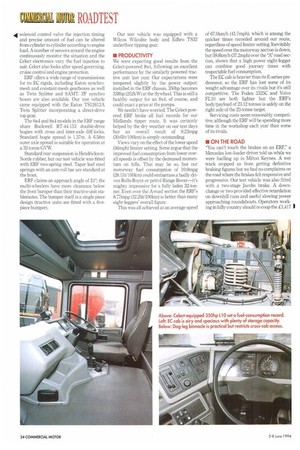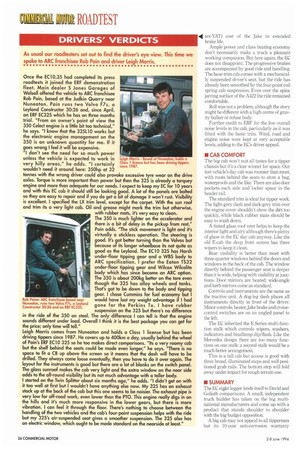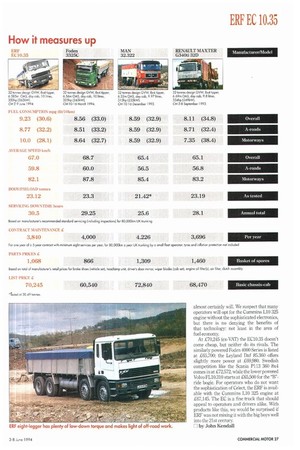MAJOR L ;ICU
Page 24

Page 26

Page 28

Page 29

If you've noticed an error in this article please click here to report it so we can fix it.
Everyone likes an underdog, so it's nice to know that a small manufacturer like ERF can produce a vehicle like the EC10.35 that can compete effectively on the world stage.
Afashionable pastime among industry watchers and some truck manufacturers is speculating on which of them will still be around at the end of the decade. Most favour the "four manufacturer" scenario with the industry dominated by the large multi-national producers. What of the rest? Consigned to the scrap heap, unable to compete because they cannot benefit from economies of scale and re-coup enormous development costs in volume sales.
That's one view. Other observers say this is no more than wishful thinking on the part of the multi-nationals than a realistic forecast. If smaller manufacturers can survive today on low sales volumes, there is no reason why they should not survive into the next century. The strength of the US market will ensure the existence of independent engine suppliers, and the likes of Cummins and Perkins can share development costs among all their purchasers, not just truck builders.
Design and tooling costs for steel pressing are certainly far too high for low-volume production, but materials like glass reinforced plastic (GRP) and Sheet Moulded Compound (SMC) will keep potentially bank-breaking cab development within reach of small manufacturers. Compare the .C600m that Volvo's spent to develop the FH range with ERF's £4m budget for the EC and it's clear there is room for both, where there is demand for both.
ERF launched the EC rigid range at the Scottish 1RTE show last September. Like the EC tractive units launched some four months before, the rigids come with a choice of Euro1 Cummins and Perkins engines.
The most powerful model in the range is the EC10.35 8x4, powered by Cummins' 10litre L350E engine: 350hp (262kW), we felt, would be more than enough to propel a 32tonner, but could it follow the EC10.35ST tractive unit (CM 2-8 Dec 1993) by setting new class records for fuel consumption? We took it round our Midlands tipper route to find out.
• PRODUCT PROFILE Cummins extracts 350hp from the LIO engine with the help of the Celect package which combines electronic unit injectors with a full engine management system. Using a
41 solenoid control valve the injection timing and precise amount of fuel can be altered from cylinder to cylinder according to engine load. A number of sensors around the engine continuously monitor the situation and the Celect electronics vary the fuel injection to suit. Celect also looks after speed governing, cruise control and engine protection.
ERF offers a wide range of transmissions for its EC rigids, including Eaton synchromesh and constant-mesh gearboxes as well as Twin Splitter and SAMT. ZF synchro boxes are also available. Our test vehicle came equipped with the Eaton TS12612A Twin Splitter incorporating a direct-drive top gear.
The 6x4 and 8x4 models in the ERF range share Rockwell RT-44-153 double-drive bogies with cross and inter-axle diff-locks. Standard bogie spread is 1.37m. A 6.58m outer axle spread is suitable for operation at a 32-tonne GVW.
Standard rear suspension is HendricksonNorde rubber, but our test vehicle was fitted with ERF two-spring steel. Taper leaf steel springs with an anti-roll bar are standard at the front.
ERF claims an approach angle of 24'; the multi-wheelers have more clearance below the front bumper than their tractive-unit stablemates. The bumper itself is a single piece design (tractive units are fitted with a fivepiece bumper). Our test vehicle was equipped with a Wilcox Wilcolite body and Edbro TS32 underfloor tipping gear.
• PRODUCTIVITY We were expecting good results from the Celect-powered 8x4, following an excellent performance by the similarly powered tractive unit last year. Our expectations were tempered slightly by the power output: installed in the ERF chassis, 350hp becomes 338hp (252kW) at the flywheel. This is still a healthy output for an 8x4, of course, and could exact a price at the pumps.
We needn't have worried. The Celect-powered ERF broke all fuel records for our Midlands tipper route. It was certainly helped by the dry weather on our test days but an overall result of 9.23mpg (30.6lit/100km) is simply outstanding.
Views vary on the effect of the lower speed (56mph) limiter setting. Some argue that the improved fuel consumption from lower overall speeds is offset by the decreased momentum on hills. That may be so, but our motorway fuel consumption of 10.0mpg (28.1lit/100km) could embarrass a badly driven Rolls-Royce or petrol Range Rover—it's mighty impressive for a fully laden 32-tonnen Even over the A-road section the ERF's 8.77mpg (32.21ft/100km) is better than many eight-leggers' overall figure.
This was all achieved at an average speed of 67.0krn/h (41.7mph), which is among the quicker times recorded around our route, regardless of speed limiter setting. Inevitably the speed over the motorway section is down, but 59.8Imi/h (37.2mph) over the "N' road section, shows that a high power eight-legger can combine good journey times with respectable fuel consumption.
The EC cab is heavier than its E-series predecessor, so the ERF has lost some of its weight advantage over its rivals but it's still competitive. The Foden 3325C and Volvo FL10 are both lighter but the ERF's body/payload of 23.12 tonnes is safely on the right side of the 23-tonne target.
Servicing costs seem reasonably competitive, although the ERF will be spending more time in the workshop each year than some of its rivals.
• ON THE ROAD You can't touch the brakes on an ERF," a Mercedes low-loader driver told us while we were fuelling up in Milton Keynes. A wet track stopped us from getting definitive braking figures but we had no complaints on the road where the brakes felt responsive and progressive. Our test vehicle was also fitted with a two-stage Jacobs brake. A downchange or two provided effective retardation on downhill runs and useful slowing power approaching roundabouts. Operators working in hilly country should re-coup the 41,417 0
• (ex-VAT) cost of the Jake in extended
brake life.
Ample power and class beating economy don't necessarily make a truck a pleasant working companion. But here again, the EC does not disappoint. The progressive brakes are accompanied by good ride and handling. The base trim cab comes with a mechanically suspended driver's seat, but the ride has already been smoothed by the four-point coil spring cab suspension. Even over the spine jarring surface of the A422 the ride remained comfortable.
Roll was not a problem, although the story might be different with a high centre of gravity bulker or refuse body.
Further credit to ERF for the low overall noise levels in the cab, particularly as it was fitted with the basic trim. Wind, road and engine noise were kept at very acceptable levels, adding to the EC's driver appeal.
• CAB COMFORT The big cab won't suit all tastes for a tipper chassis but it's a clear winner for space. Our test vehicle's day cab was roomier than most, with room behind the seats to stow a bag, waterproofs and the like. There are also door pockets each side and locker space in the header rail.
The standard trim is ideal for tipper work. The light-grey dash and dark-grey trim over the engine cover shouldn't show the dirt too quickly, while black rubber mats should be easy to wash down.
A tinted glass roof vent helps to keep the interior light and airy although there's plenty of glass in the EC day cab anyway. Like the old E-cab the deep front screen has three wipers to keep it clean.
Rear visibility is better than most with three-quarter windows behind the doors and windows in the back of the cab. The window directly behind the passenger seat is deeper than it is wide, helping with visibility at junctions. Door mirrors are heated; wide-angle and kerb mirrors come as standard.
Controls and instruments are the same as the tractive unit. A dog-leg dash places all instruments directly in front of the driver. Minor controls, heater, Jake brake and cruisecontrol switches are on an angled panel to the left.
The EC inherited the E-Series multi-function stalk which controls wipers, washers, indicators and headlamp dip/flash. Like the Mercedes design there are too many functions on one stalk: a second stalk would be a much better arrangement.
This is a tall cab but access is good with three broad, illuminated steps and well positioned grab rails. The bottom step will fold away under impact for rough terrain use.
• SUMMARY The EC ei*ht-legger lends itself to David and Goliath comparisons. A small, independent truck builder has taken on the big multinational manufacturers and come up with a product that stands shoulder to shoulder with the big-budget opposition.
A big cab may not appeal to all tippermen but its 10-year anti-corrosion warranty
almost certainly will. We suspect that many operators will opt for the Cummins L10 325 engine without the sophisticated electronics, but there is no denying the benefits of that technology: not least in the area of fuel economy.
At £70,245 (ex-VAT) the EC10.35 doesn't come cheap, but neither do its rivals. The similarly powered Foden 4000 Series is listed at £65,700; the Leyland Daf 85.360 offers slightly more power at £69,980. Swedish competition like the Scania P113 360 8x4 comes in at £72,572, while the lower powered Volvo FL10,310 starts at £65,500 for the "B"ride bogie. For operators who do not want the sophistication of Celect, the ERF is available with the Curnmins L10 325 engine at £67,145. The EC is a fine truck that should appeal to operators and drivers alike. With products like this, we would be surprised if ERF was not mixing it with the big boys well into the 21st century.
by John Kendall
















































































